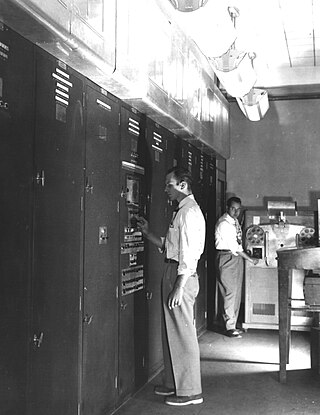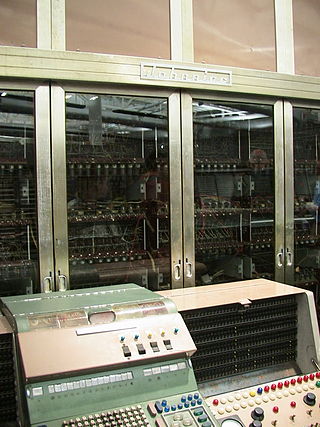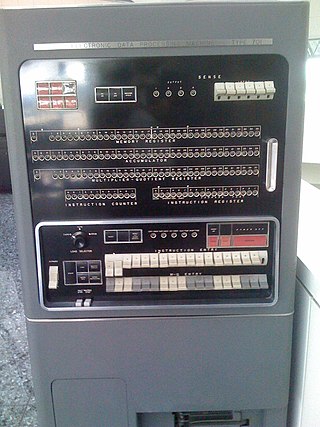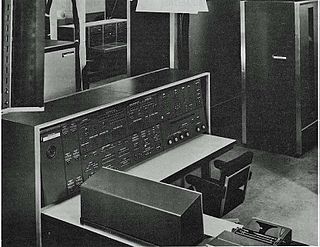
The IBM 704 is the model name of a large digital mainframe computer introduced by IBM in 1954. It was the first mass-produced computer with hardware for floating-point arithmetic. The IBM 704 Manual of operation states:
The type 704 Electronic Data-Processing Machine is a large-scale, high-speed electronic calculator controlled by an internally stored program of the single address type.

EDVAC was one of the earliest electronic computers. It was built by Moore School of Electrical Engineering, Pennsylvania. Along with ORDVAC, it was a successor to the ENIAC. Unlike ENIAC, it was binary rather than decimal, and was designed to be a stored-program computer.

The UNIVAC I was the first general-purpose electronic digital computer design for business application produced in the United States. It was designed principally by J. Presper Eckert and John Mauchly, the inventors of the ENIAC. Design work was started by their company, Eckert–Mauchly Computer Corporation (EMCC), and was completed after the company had been acquired by Remington Rand. In the years before successor models of the UNIVAC I appeared, the machine was simply known as "the UNIVAC".

UNIVAC was a line of electronic digital stored-program computers starting with the products of the Eckert–Mauchly Computer Corporation. Later the name was applied to a division of the Remington Rand company and successor organizations.

The JOHNNIAC was an early computer built by the RAND Corporation and based on the von Neumann architecture that had been pioneered on the IAS machine. It was named in honor of von Neumann, short for John von NeumannNumerical Integrator and Automatic Computer.

The ERA 1101, later renamed UNIVAC 1101, was a computer system designed and built by Engineering Research Associates (ERA) in the early 1950s and continued to be sold by the Remington Rand corporation after that company later purchased ERA. Its (initial) military model, the ERA Atlas, was the first stored-program computer that was moved from its site of manufacture and successfully installed at a distant site. Remington Rand used the 1101's architecture as the basis for a series of machines into the 1960s.

The IBM 701 Electronic Data Processing Machine, known as the Defense Calculator while in development, was IBM’s first commercial scientific computer and its first series production mainframe computer, which was announced to the public on May 21, 1952. It was designed and developed by Jerrier Haddad and Nathaniel Rochester and was based on the IAS machine at Princeton.

The UNIVAC 1102 or ERA 1102 was designed by Engineering Research Associates for the United States Air Force's Arnold Engineering Development Center in Tullahoma, Tennessee in response to a request for proposal issued in 1950. The Air Force needed three computers to do data reduction for two wind tunnels and an engine test facility.
The Cyclone is a vacuum-tube computer, built by Iowa State College at Ames, Iowa. The computer was commissioned in July 1959. It was based on the IAS architecture developed by John von Neumann. The Cyclone was based on ILLIAC, the University of Illinois Automatic Computer. The Cyclone used 40-bit words, used two 20-bit instructions per word, and each instruction had an eight-bit op-code and a 12-bit operand or address field. In general IAS-based computers were not code compatible with each other, although originally math routines which ran on the ILLIAC would also run on the Cyclone.

The UNIVAC 1100/2200 series is a series of compatible 36-bit computer systems, beginning with the UNIVAC 1107 in 1962, initially made by Sperry Rand. The series continues to be supported today by Unisys Corporation as the ClearPath Dorado Series. The solid-state 1107 model number was in the same sequence as the earlier vacuum-tube computers, but the early computers were not compatible with their solid-state successors.

The UNIVAC 1103 or ERA 1103, a successor to the UNIVAC 1101, is a computer system designed by Engineering Research Associates and built by the Remington Rand corporation in October 1953. It was the first computer for which Seymour Cray was credited with design work.
The UNIVAC Solid State was a magnetic drum-based solid-state computer announced by Sperry Rand in December 1958 as a response to the IBM 650. It was one of the first computers offered for sale to be (nearly) entirely solid-state, using 700 transistors, and 3000 magnetic amplifiers (FERRACTOR) for primary logic, and 20 vacuum tubes largely for power control. It came in two versions, the Solid State 80 and the Solid State 90. In addition to the "80/90" designation, there were two variants of the Solid State – the SS I 80/90 and the SS II 80/90. The SS II series included two enhancements – the addition of 1,280 words of core memory and support for magnetic tape drives. The SS I had only the standard 5,000-word drum memory described in this article and no tape drives.

The UNIVAC LARC, short for the Livermore Advanced Research Computer, is a mainframe computer designed to a requirement published by Edward Teller in order to run hydrodynamic simulations for nuclear weapon design. It was one of the earliest supercomputers.
The UNIVAC III, designed as an improved transistorized replacement for the vacuum tube UNIVAC I and UNIVAC II computers, was introduced in June 1962, with Westinghouse agreeing to furnish system programing and marketing on June 1, 1962. It was designed to be compatible for all data formats. However the word size and instruction set were completely different; this presented significant difficulty as all programs had to be rewritten, so many customers switched to different vendors instead of upgrading existing UNIVACs.
The UNIVAC 418 was a transistorized, 18-bit word magnetic-core memory machine made by Sperry Univac. The name came from its 4-microsecond memory cycle time and 18-bit word. The assembly language for this class of computers was TRIM III and ART418.

The UNIVAC II computer was an improvement to the UNIVAC I that the UNIVAC division of Sperry Rand first delivered in 1958. The improvements included the expansion of core memory from 2,000 to 10,000 words; UNISERVO II tape drives, which could use either the old UNIVAC I metal tapes or the new PET tapes; and some transistorized circuits. It was fully compatible with existing UNIVAC I programs for both code and data. It weighed about 16,000 pounds.

The IBM 702 was an early generation tube-based digital computer produced by IBM in the early to mid-1950s. It was the company's response to Remington Rand's UNIVAC, which was the first mainframe computer to use magnetic tapes. As these machines were aimed at the business market, they lacked the leading-edge computational power of the IBM 701 and ERA 1103, which were favored for scientific computing, weather forecasting, the aircraft industry, and the military and intelligence communities.
CALDIC is an electronic digital computer built with the assistance of the Office of Naval Research at the University of California, Berkeley between 1951 and 1955 to assist and enhance research being conducted at the university with a platform for high-speed computing.

A vacuum-tube computer, now termed a first-generation computer, is a computer that uses vacuum tubes for logic circuitry. While the history of mechanical aids to computation goes back centuries, if not millennia, the history of vacuum tube computers is confined to the middle of the 20th century. Lee De Forest invented the triode in 1906. The first example of using vacuum tubes for computation, the Atanasoff–Berry computer, was demonstrated in 1939. Vacuum-tube computers were initially one-of-a-kind designs, but commercial models were introduced in the 1950s and sold in volumes ranging from single digits to thousands of units. By the early 1960s vacuum tube computers were obsolete, superseded by second-generation transistorized computers.
Philco was one of the pioneers of transistorized computers. After the company developed the surface barrier transistor, which was much faster than previous point-contact types, it was awarded contracts for military and government computers. Commercialized derivatives of some of these designs became successful business and scientific computers. The TRANSAC Model S-1000 was released as a scientific computer. The TRANSAC S-2000 mainframe computer system was first produced in 1958, and a family of compatible machines, with increasing performance, was released over the next several years.














